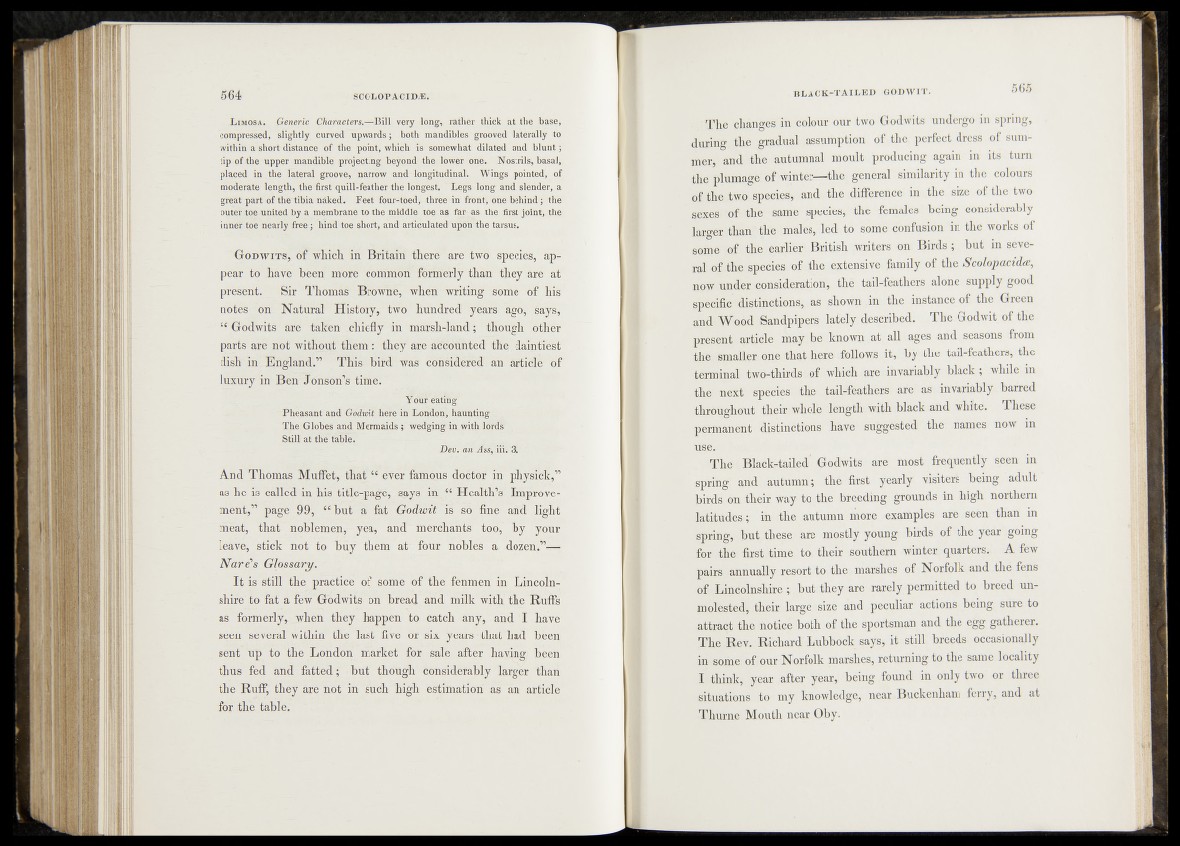
L i m o s a . Generic Characters.—B|(S. very long, rather thick at base,
compressed, slightly curved upwards; both mandibles grooved laterally to
within a short distance of the point, which is somewhat dilated and blunt;
tip of the upper mandible projecting beyond the lower one.' Nostrils, basal,
placed in „the lateral groove, narrow and longitudinal;. Wings pointed, of
moderate length, the first quill-feather the longest. Legs long and slender, a
greatpart of thetlbia naked/ /Eeet four-tbed; three in front', one behind; the
outer toe united by a membrane to the middle toe as far-as the first joint, the
inner toe nearly free; hind toe short, and articulated upfin the tarsus.
G o dw it s , oi whibh ih Britain there''-are two* species, appear
to have been more common formerly than they'àrë a t1
présent. Sir Thomas Browne, when1 writing some'’of his'
notés on Natural History, two hundred’ years ago, says,
“ Godwits are taken .chiefly in '-M$Ersk-land ; though father
parts are not without them : the ƒ are à&$oebtèd the^ dainfies\
' This bird was con sidled*: an article' of
luxury in Ben Jóhsbii’s tim e ly
Y oW eatmg
—Pheasant and Gvitwit ânere,iü’--LôîMdn, haunting _ _
The Globes andMermaids ; wedging in^yvith lords'
Stilt at the taÊîe.
pw;~ari Æss1, 'ffi.'S.’
And Thomas Muffet, that “ ever famous docïór in" p n p lp ,”
as fie is called in his title-page, says in .“ Health’s Improvement,”
page 99, “ but à fat;Goamt' fspw*mie' aifa light
meat, that * noblemeny-yea, ana merchants,' tnof by yjomr
leave, stick not to buy them a t' four nobles a .dozen, —,
Nave’s Glossary. ■'
I t is still the practice of some of the fenmen in Lincoln-'
shire'to fat a few Godwits on bread and milk with, the Ruffs
as formerly,,when they happen ta catch any, and T have
seen several within the last five or six years-that had been
sent up to the London market -for sale jafter haying been
thus fed and fatted ; but though considefably largér than
the Ruff,* they are not in such high estimation as an article
for the table!
The changes in colour our two Godwits undergo in spring,
during the gradual assumption of the perfect dress of summer,
and the autumnal moult producing again in its turn
the plumage of winter—the general similarity in the colours
of the two species, and the difference in the size of the two
sexes -of the same species, the females being considerably
larger than 'the males, led to some confusion in the works of
some of the earlier British writers on Birds; but in several
of the species of the extensive family of the Scolopacida,
now under consideration, the tail-feathers alone supply good
specific distinctions, as shown in the instance of the Green
and Wood Sandpipers lately described. The Godwit of the
present article may be known at all ages and seasons from
the smaller one. that here follows it, by the tail-feathers, the
terminal two-thirds of which aye invariably black; while in
the next species the tail-feathers are as invariably barred
throughout their whole length, with black and whfte. These
permanent distinctions have1, suggested the names now in
use
The Black-tailed' Godwits are most frequently seen in
spring' and autumn; the first yearly visiterS being adult'
birds on their way to-the breeding grounds in high northern
latitudes; in the .autumn more examples are seen than in
spring, but these are mostly young birds of the year going
for the-, first time to their southern winter quarters. A few
pairs annually resort to the marshés of Norfolk and the fens
of ^Lincolnshire 4 4 u t they are rarely permitted to breed unmolested^
their large, size and peculiar actions being sure to
attract the notice both of the sportsman and the egg gatherer.
The Rev. Richard Lubbock says, it still breeds occasionally
in some! of our Norfolk marshes, returning to the same locality
I think, year after year, being found in only two or three
situations to my knowledge, near Buckenham ferry, and at
Thurne Mouth near Oby.